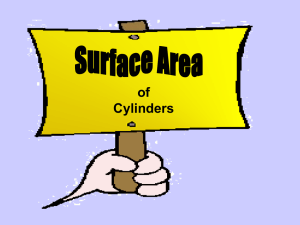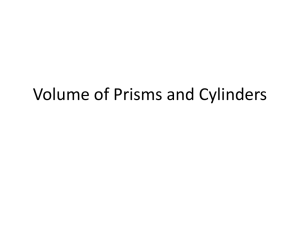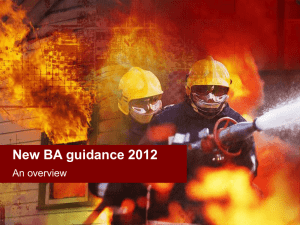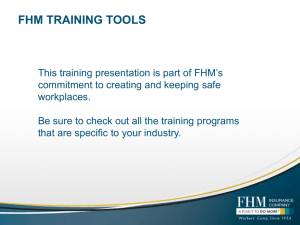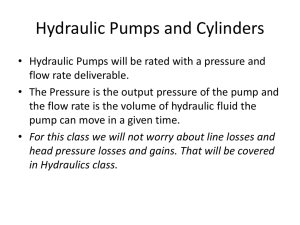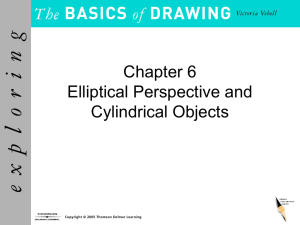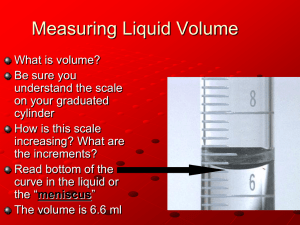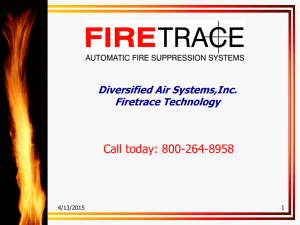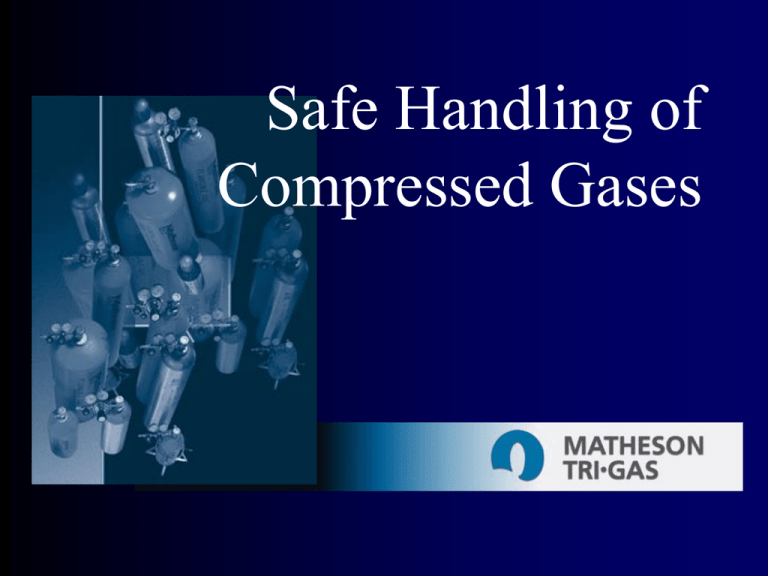
Safe Handling of
Compressed Gases
Reasons for a Safety Seminar
• To heighten the awareness of the
dangers associated with compressed
gases
• To encourage safe operating practices
in their everyday use
• To help ensure the right equipment is
used for your application
Definition
Compressed Gas
Any material or mixture
with an in-container
pressure exceeding 40 psia
at 70F, or a pressure
exceeding 104 psia at
130F, or any liquid
flammable material having
a vapor pressure exceeding
40 psia at 100F [sec.
173.300(a)].
The Gas: Rule #1!
Know the properties of the materials involved
Gases may be:
• Under high pressure
• Toxic
• Corrosive
• Flammable
• Pyrophoric
• Oxidizers
High Pressure Gas
• Can cause equip. to fail with explosive force
• When released can diffuse into the atmosphere
very rapidly, and an entire room may be
thoroughly contaminated within seconds!
• A common 9” dia X 52” high cylinder
pressurized to 2000 psi has the stored energy
equivalent to one pound of dynamite!
• Cylinders are commonly filled to standard
pressures of 2000 psi, 2490 psi, 3500 psi and
6000 psi.
Toxic Gases
• Have the ability to cause injury or
death when ingested or absorbed by
the skin
• Examples include Ammonia, Vinyl
Chloride and Phosgene
Corrosive Gases
• Will attack and damage human tissue
• Will have an adverse effect on
improper materials of construction
• Examples of corrosive materials are
Hydrogen Chloride, Hydrogen
Fluoride
Flammable & Pyrophoric Gases
• Flammable gases easily catch fire and burn
rapidly in air
• Examples of flammable gases are Acetylene,
Hydrogen, Propane, and Propylene
• Pyrophoric gases spontaneously ignite and
burn when exposed to the atmosphere
• Silane is a pyrophoric gas which is commonly
used in the electronics industry
Liquefied Compressed Gases
• Contents of a
liquefied compressed
gas cannot be
determined by the
pressure in the
cylinder, and a
cylinder scale must
be used
Shipping Regulations
Dept. of Transport (D.O.T.) regulations specify the familiar
diamond shaped tag that must be affixed to each cylinder being
shipped
Material Safety Data Sheets
• Required in workplace
• Substance fact sheet listing
characteristics, hazards and as
much detail as possible
concerning the particular gas
SECTION 4
FIRST AID MEASURES
INHALATION: If adverse effects occur, remove to
uncontaminated area. Give artificial respiration if
not breathing. If breathing is difficult, oxygen should
be administered by qualified personnel. Get
immediate medical attention.
SKIN CONTACT: If frostbite or freezing occur,
immediately flush with plenty of lukewarm water
(105-115 F; 41-46 C).
Threshold Limit Values (TLV’s)
• Time Weighted Average (TWA)
- Average 8 hour exposure, 5 days a week
• Short Term Exposure Limit (STEL)
- 15 minutes, 4 times a day
• Immediately Dangerous to Life and Health
(IDLH)
Personal & Fixed Gas Monitors
Compressed Gas Cylinders
• Come in many shapes and
sizes
• Commonly constructed of
Carbon Steel or Aluminum
• Standard size 1A cylinder
pressurized to 2200 psig holds
approx. 225 ft3 of gas in an
internal volume of 1 ½ ft3!
Cylinder Identification
And Markings
1
Specification number consists of three sections.
• DOT- signifies that the cylinder
conforms to Department of
Transportation (DOT) specification.
• 3AA - specifies type and material of
cylinder construction.
• 2265 - indicates service pressure
for which the cylinder is designed
at 70F.
Cylinder Identification
And Markings
2
Cylinder serial number
(Matheson Tri-Gas number)
Cylinder Identification
And Markings
3
Date of initial hydrostatic
testing
Cylinder Identification
And Markings
4
Original inspector's insignia
Cylinder Retest Schedule
Specification under which
cylinder was made
Minimum
retest pressure (psi)
Retest
period (years
DOT-3
3000 psi
5
3D
5/3 times service pressure
5
4
700 psi
10
DOT-9
400 psi (maximum 600 psi)
5
26 for filling at over 450 psi
5/3 times service pressure
5
33
800 psi
5
CGA Connections
• Compressed Gas Assoc.
• Reasons for CGA standards
• CGA gaskets/washers
• Restricted flow orifices
CGA Connections
Matheson Tri-Gas
Product Safety & Code Compliance
Primary Governing Bodies / Safety Codes
Compressed Gas Association (CGA)
Semiconductor Equipment & Materials International (SEMI)
US Environmental Protection Agency (EPA)
Uniform Fire Code / Local City Regulatory Committee (UFC)
Uniform Building Code (UBC) / BOCA
National Fire Prevention Code (NFPC)
International Conference of Building Officials (IBOC)
Toxic Gas Ordinance (TGO)
Cylinder Handling and
Transportation
• Upon receipt, visually inspect the cylinders for obvious
defects such as dents, large amounts of rust and missing
or loose safety caps.
• Cylinders shouldn’t be accepted unless identified with
the appropriate labeling, and all them agree with one
another!
• Use a cylinder cart and secure the cylinders with a chain
when moving.
• Don’t use the protective valve caps for moving or lifting
the cylinders.
Cylinder Handling and
Transportation
• Don’t drop a cylinder, permit them to strike each other
violently or be handled roughly.
• Unless cylinders are secured, regulators should be
removed, valves closed and protective caps in place
before cylinders are moved.
• Rolling cylinders in a vertical position on the bottom
edge is to be avoided as much as possible. Gas cylinders
must never be dragged or rolled in the horizontal
position.
Cylinder Storage
• Double restrain cylinders
with non-combustible
material (i.e., chain)
• Label Full versus Empty
• Signs for hazardous gases
• Keep away from traffic areas
• Store in fire resistant, well
ventilated, dry areas
Cylinder Storage
•
•
•
•
Keep away from flames or sparks
Keep caps on when not in use
Store in areas <125°F
Keep oxidizers 20 ft. from
flammables
• Corrosives should be stored less than
6 months
Pressure Regulators
and How They Work
Single Stage Regulator
Outlet
gauge
Inlet
gauge
Temporary
shut-off
valve
CGA inlet
connection
P/A knob
Single Stage Regulator
Reduces the inlet supply
pressure in “one step”,
from the inlet supply
pressure to the final outlet
pressure
Single Stage Regulator
Applications:
• Intermittent use - where a
sample of gas is required
from a cylinder
• Where pressure rise in a set
delivery pressure is not
critical
• As a line regulator where
there is a second pressure
regulator at the gas supply
source
Single Stage Regulator
Characteristics:
Rule of thumb: for every
100 psig drop on the inlet
pressure, there will be 1
psig rise on the outlet
working pressure
Two-Stage Regulator
Reduces the pressure in
“two steps” from a high
pressure inlet source, to the
final outlet working
pressure
Two-Stage Regulator
Characteristics:
• Delivery “set pressure”
remains constant as the inlet
supply pressure decays
• Becomes a single stage regulator
when the source supply pressure
becomes less than the set pressure
of the first stage (~300 psig)
• Can be supplied with an inter-stage
relief valve as insurance in the
event of first stage seat failure
Two-Stage Regulator
Applications:
• Recommended for continuous
use applications, such as carrier
gas supply to GC’s or other
analytical instruments, where
it is critical that a constant
delivery set pressure be
maintained
Regulator Installation
• Do not use CGA adaptors or change
CGA connections on regulators for a
different gas service – unless work is
done by qualified personnel!
• Always ensure there are no nicks and
scratches on regulator CGA
connections
• Never use Teflon tape to achieve a
proper seal
• Always leak check connections using a
soap bubble solution or electronic leak
detector
Regulator Operation
• Always ensure the P/A knob is backed off
counterclockwise to ensure there is no load on the
regulator load spring – prior to opening the cyl valve!
• Never open a cylinder valve all the way. 1 ½ to 2 turns is
usually sufficient
• Always stand with the cylinder valve between you and
the regulator when opening the cylinder valve and/or
adjusting pressure on the regulator
• Do not use the temporary shut-off valve to turn off gas
flow if the shut-off duration will be longer than 20 min.
• Use cross or T-purge assemblies if regulators are to be
used for toxic or corrosive gases!
Regulator Failures
• 95% of regulator failures are due to seat
failures, caused by:
– Corrosion buildup on the seat
– Contamination (dirt, metal filings, Teflon tape)
that scores the seat at a high velocity
Set pressure creep on the delivery pressure
gauge indicates a seat failure!
Regulator Failures
• A Pressure gauge that will not read zero
indicates the bourdon tube has been
damaged and the gauge must be replaced!
• Gas leaking through the bonnet assembly of
the regulator indicates a diaphragm failure
(Typically caused by failure to ensure the
regulator is shut off prior to installing it on
a new cylinder)
Safety Devices:
• Check valve: prevents reverse
gas flow
• Flash Arrestor: prevents
ignition source from reaching
regulator and cylinder for
flammables
• Excess Flow Valve: restricts
flow in the event of a gas line
break
Things Not To Do!
• Never roll a cylinder to move it.
• Never carry a cylinder by the valve.
• Never leave a cylinder unsecured.
• Never force improper attachments
on to the wrong cylinder.
• Never grease or oil the regulator, valve
or fittings of an oxygen cylinder.
• Never refill a cylinder.
• Never attempt to mix gases in a cylinder.
Safe Gas Usage
• Compressed gases serve laboratories and industrial
plants in many ways, but the cylinders and gases present
a number of hazards.
• “Treat all gas cylinders, full or empty, as objects that
have a very real potential to injure you severely.”
Consider
Reduction/elimination of gas cyl’s in the lab
• Through a centralized gas distribution system
• Gas generators for H2, N2 or Zero Air
Emergency Plan
• Every location where compressed gases are
handled should have a written emergency
plan covering steps to be taken in the event
of an accidental release of gas
• This plan should consider the nature of the
gases being handled, that is their chemical
and physical properties
Plan Elements
At a minimum, the plan should specify the
following :
• Alarm System & Evacuation Procedure
• Response Personnel
• Emergency Equipment
• Containment or disposal methods
Additional Safety Information
Additional Safety Information
Safety is our First Priority
All rights reserved. No part of this presentation may be reproduced or used in any form whatsoever without the express written
permission of Matheson Tri-Gas, Inc.; except in the case of brief quotations embodied in critical articles and reviews. The
information contained here is for the personal use of the reader and may not be incorporated in publications, databases, or
software programs without the written consent of Matheson Tri-Gas, Inc.
This publication is intended to provide accurate information in regard to the subject matter covered and has been obtained from
sources believed to be reliable. Of necessity the information is abbreviated and other information, training and/or education is
required of the user of this information. Accordingly, Matheson Tri-Gas, Inc. makes no warrantees, guarantees, or
representations of any kind or nature with respect to the information published herein, either express or implied, and whether
arising by law or otherwise, including but not limited to any implied warranty of merchantability or fitness for any particular
purpose, and shall not be responsible for any errors, omissions, or damages arising out of use of this information. Matheson shall
in no event be liable for any personal injuries, property or other damages of any nature whatsoever, whether special, indirect,
consequential or compensatory, directly or indirectly resulting from the publication of, or reliance upon the information.

